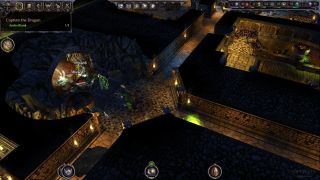It might seem improbable, but one of the most important effects of Impire, the new video game developed by Cyanide and published by Paradox Interactive, is that it will make it almost impossible to think or write for a number of days without noticing how pervasive the particle “imp” is in the English language and how easy it is to build puns around it.
It helps that the Impire game experience itself is pretty impressive, mixing humor and interesting player choices with challenging gameplay that requires careful resource management, good strategy and solid use of available squads.
Story
The game is set in the world of Ardania, but players do not need any information about it to enjoy Impire as long as they have a working knowledge of core fantasy concepts and are willing to have some of them turned on their heads.
The game has a wide variety of hero and monster classes, a world with a medieval look and characters that lack a coherent personality but try and complement their presence with humor.
I have got a few chuckles out of Impire, but I have never felt that the developers have struck comedy gold with their writing or with the way the various actors deliver their lines, which sometimes feel entirely improvised.The single-player campaign tries to weave an impressive, heroic (for a bad guy) story, but I have never felt that it was worth getting through the game to reach its resolution, with the core gameplay of Impire being the main reason that I have stuck to it in the long term.
Gameplay
Impire is a mix between a dungeon development simulator and a party-based action role-playing game, borrowing a number of ideas from both genres in order to create a hybrid experience that will be compared by many to Dungeon Keeper, but has entirely different aims and might surprise many fans.
Impire is built around two systems, one used to create buildings and develop upgrades and another that allows the player to control squads of creatures that fight enemies and achieve objectives.
The levels are well designed and Impire adds core objectives and side quests in order to keep the player busy and working hard to perfect his dungeon, while also protecting his holdings against hero marauders.The first thing that players need to do is to create the basic infrastructure of resource gathering and unit production, then add more rooms in order to boost their creatures, which need to be grouped into squads in order to fight at maximum efficiency.
Once the base is ready and at least one squad can face heroes that seek to invade it and gather treasure from the poor imps, an array of options open up: players can raid the outer world for more goodies, they can continue improving their squads or they can go after one of the level objectives.
Impire is a game that’s not afraid to set the player back and powerful squads with good upgrades are required to achieve the final objectives, which are marked by a tough fight with boss-level creatures. The experience can be frustrating at times, but that’s only because modern games have made the public get used to a lack of punishment for back choices.
Impire is the kind of game that drops a squad of heroes in the middle of your base exactly when the two three-monster squads you have are all out raiding and I was initially furious at the game because of that.
But the fault was clearly mine, because I had failed to protect my most important assets and after I had learned the painful lesson, I have never again left my treasure room unprotected, despite feeling the temptation on several occasions.
As I have played more Impire, I have also become a little annoyed with the artificial barriers that the developers have placed, forcing me to approach each level in a pre-determined way, and there are times when the game seems too focused on squad management and upgrade.
Gamers need distributive attention to deal with everything that’s happening in the game and even for an experienced strategy fan, there will be moments when the game seems to be moving too fast, throwing too many challenges at the player.
Resources need to be constantly increased in order to be able to make creatures to replace those already destroyed and expand the dungeon.
As any Impire level progresses, gamers also get access to a number of potential upgrades, including new units, better traps, new rooms to build and abilities for some of their own creatures.
Learning what achievements to prioritize and then unlocking the best units and upgrades becomes more important as the campaign progresses and players need to pay attention to the various upgrade paths and their requirements.
The titular Imp, named Baal, also increases in strength as Impire progresses, but he remains fairly squishy in combat situations and needs significant backup from his minions in order to deal with the biggest monsters and heroes that he faces.
The campaign is pretty lengthy and very challenging at times, but for some players, the somewhat repetitive nature of the tasks might lead to an early exit.
The skirmish maps are well built and the Capture the Dragon mode manages to introduce some much needed variation to the game.
I would have just liked to see more overall variety in the design for Impire and more decisions with attached branching paths.
Graphics and audio
Impire is played from a top down perspective and I seem to spend most of the time with the game immersed in the strategic view that allows me to build units and develop my base while quickly spotting enemy threats or assaulting heroes.
It’s nice to zoom in from time to time in order to see the actual battles and there are delightful touches in the graphics and animation department, like the way the squads feed or the training moves they go through.
The sound design for Impire is less impressive and the game fails to find a good tone for its voice actors or a soundtrack that innovates on generic fantasy themes.
Multiplayer
For Impire, the development team has created both a cooperative mode for the single-player campaign, allowing gamers to join in order to reach objectives, and competitive multiplayer that can take place on all the skirmish maps.
At the moment, the features are still labeled as beta by the Cyanide studio because there are still some issues that need to be addressed.Impire is a solid single-player experience but, as always, gaming against other humans introduces an entirely new set of challenges and forces the gamer to devise new strategies.
I loved the control I had over my minions and the way different unit types worked together as part of a squad, creating strategies to deal with the various challenges that Impire threw at me. The game also uses its fantasy setting well, even if at some point I would have appreciated more narrative quality and fewer attempts at humor. Impire needs to be admired for its dungeon development, the squad mechanics and the upgrade builds rather than for its setting or story.
The Good
The Bad
Conclusion
 14 DAY TRIAL //
14 DAY TRIAL // 































